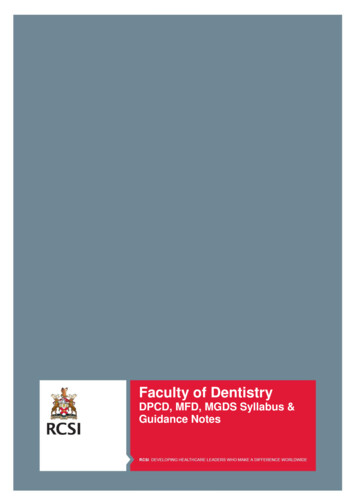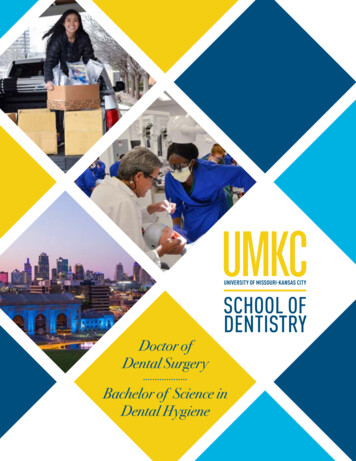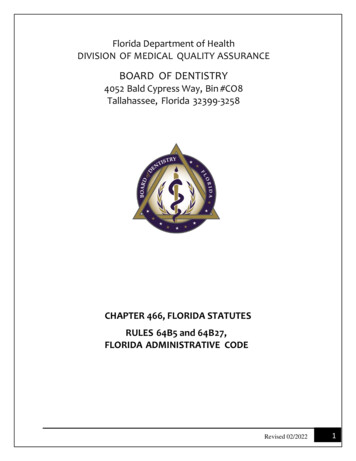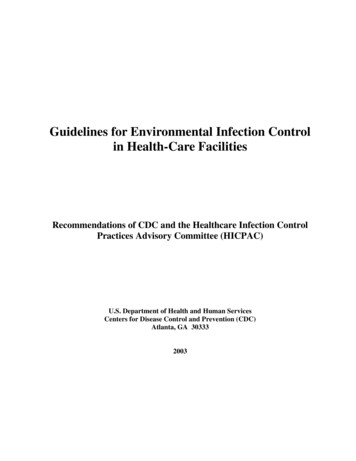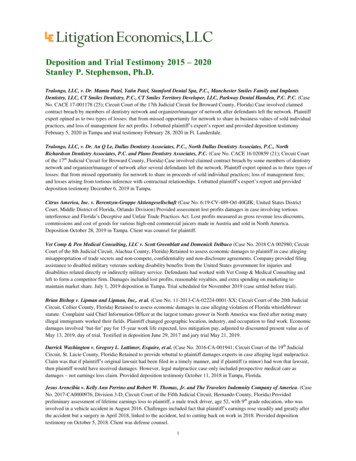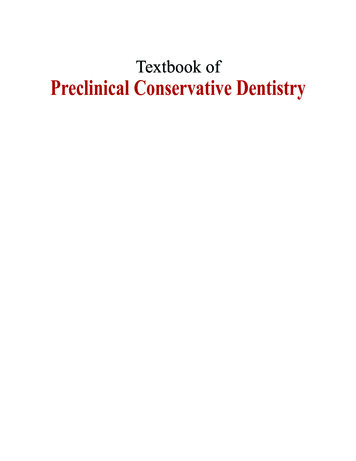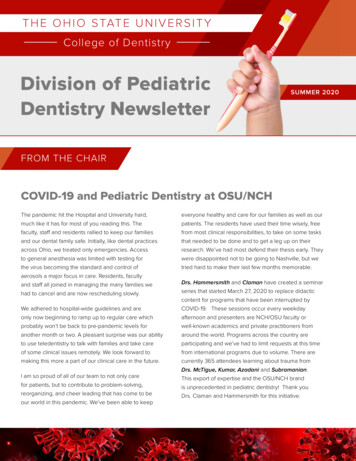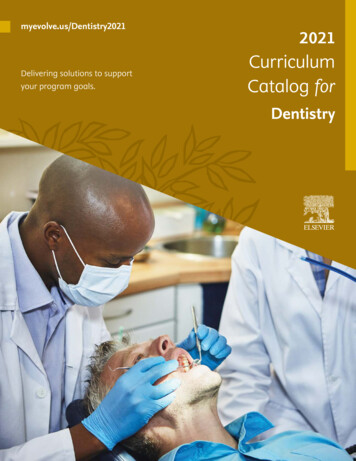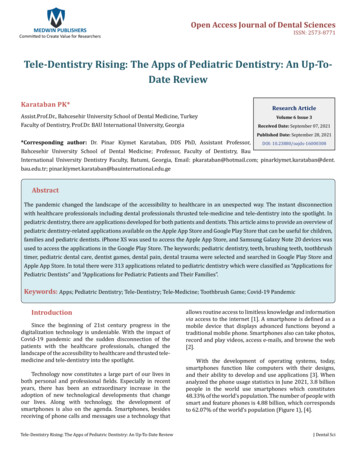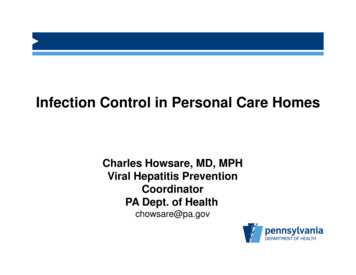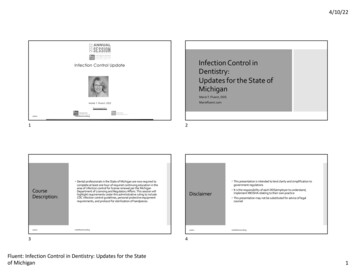
Transcription
4/10/22Infection Control inDentistry:Updates for the State ofMichiganInfection Control UpdateMarie T. Fluent, DDSMariefluent.comMarie T. Fluent, DDSSponsored 4/10/22 This presentation is intended to lend clarity and simplification togovernment regulations Dental professionals in the State of Michigan are now required tocomplete at least one hour of required continuing education in thearea of infection control for license renewal per the MichiganDepartment of Licensing and Regulatory Affairs. This session willhighlight requirements under this administrative ruling to includeCDC infection control guidelines, personal protective equipmentrequirements, and protocol for sterilization of handpieces.Disclaimermariefluentconsulting3Fluent: Infection Control in Dentistry: Updates for the Stateof Michigan4/10/22 It is the responsibility of each DDS/employer to understand,implement MIOSHA relating to their own practice This presentation may not be substituted for advice of legalcounselmariefluentconsulting41
4/10/22DescribeCourseObjectives:DiscussDescribe pertinent CDC Guidance documents to ensure safedental careCompliance inMichigan:Discuss the importance of handpiece sterilization after useManufacturer’sInstructions for UseUnderstand PPE requirements for safe clinical care and forUnderstand other tasks within the dental uentconsultingIn other words: Since the Michigan Board of Dentistry now recognizes CDCGuidelines as Best Practices and enforces CDC recommendations,these recommendations are now considered ”Standard of Care”and are no longer fying Compliance in MichiganProvides GuidanceRegulatoryAmerican Dental Association(ADA)Michigan Licensing and Regulatory Affairs (LARA)Michigan Dental Association(MDA)Compliance inGovernor’s Executive OrdersOrganizationfor Safety, Asepsis,Michigan:and Prevention (OSAP)OSHA/MIOSHA StandardsCenters for Disease Control andPrevention (CDC)4/10/22Michigan Department of Health and Human Services(MDHHS)Environmental Protection Agency (EPA) , Food and DrugAdministration (FDA)NOTE: Michigan Board of Dentistry ENFORCES CDCmariefluentconsultingGuidance7Fluent: Infection Control in Dentistry: Updates for the Stateof Michigan82
4/10/22Principle CDCDocuments:Also Note: Where there is a discrepancy between OSHA/MIOSHA Standardsand CDC Guidelines, follow the more stringent of the riefluentconsulting10 al-settings.htmlCDC Guidancefor COVID-19In Dentistry: As of 9-10-21: Infection control for the dental setting IS NOW onInfection control for ALL healthcare /hcp/infectioncontrol-recommendations.htmlMIOSHA /OSHA Compliance UpdatesMIOSHA COVID-19 Preparedness PlanCOVID-19 Vaccine informationCOVID-19 COVID-19 Infection or Exposure RecommendationsTip:See MDAWebsite /4/10/22mariefluentconsulting11Fluent: Infection Control in Dentistry: Updates for the Stateof Michigan4/10/22mariefluentconsulting123
4/10/22Most trolsTrainingSubstitutionHierarchy ofControls:COVID-19Preparednessand ResponsePlanHealthSurveillanceEngineeringUnder the MIOSHAEmergency Rules,Healthcare facilitiesMUST create a COVID19 Preparedness andResponse Plan.AdministrativeControlsFor a MIOSHA template, visit:AdministrativeControlsPPEHand HygieneEnvironmentalSurfaces4/10/22OSAP/DQP Best Practices for Infection Control inmariefluentconsultingDental Clinics During the COVID-19 PandemicPPELeast VID19 Preparedness Response Plan 693288 7.pdf Total new casesper 100,000persons in past ,admissions, andbeds available New COVID-19Cases What Prevention Steps Should You Take Based on yourCOVID-19 Community Level?COVID-19Community LevelTotal NEW cases0-9 Low10-49 Moderate50-99 Substantial 100 Highmariefluentconsulting15Fluent: Infection Control in Dentistry: Updates for the Stateof unty.html164
4/10/22 Patients, employees, and non-employees must be screenedHazardAssessment:ScreeningUpdates: Encourage Hand hygiene (posters, training) Screening record retention requirement is not longer in place Promote remote work (if possible) MDA recommends maintaining records for at least 6 months Screening records should be included in patient’s health recordAdministrativeControls Temperature checks are NOT required as part of the screeningprocess17 Stagger break times and lunch breaks Screening of all who enter the facilty May be conducted by asking employees to self-monitor beforereporting to work OR may be conducted in-person by employermariefluentconsulting Rotate shifts to reduce number of employees onsite Posters, signs, barriers, floor markers to reduce congestion Employee ices/4/10/22 Restrict non-essential visitors Those with suspected or confirmed COVID-19 are not permitted lanceAdministrativeControlsSocialDistancing: No longer social distancing requirements for dental s/mariefluentconsulting4/10/2219Fluent: Infection Control in Dentistry: Updates for the Stateof Michigan4/10/22mariefluentconsulting205
4/10/22Aerosols vs. DropletsAerosolDropletAerosols vs.How long can it stay aloft? Droplets: 5 µm 5 µmStays in air minutes to hoursFalls within seconds to minutesHow far can it travel? Greater than 6 feetLess than 6 feetEfficiency of removal by masks andfilters Filtering more difficultFiltered more easilyWhere it deposits in respiratory system*Inhaled deeper into respiratory systemSprayed onto body in form of contacttransmission and/or superficial areas ofrespiratory systemTrainingTrainingTransmissionRoutes:Direct ContactLarge droplet spray( 5 µm at close range 2 m)mariefluentconsulting4/10/22Indirect ContactAerosols( 5 µm and happening mainlyat long distance 2m)21*Recognition of aerosol transmission of infectious agents: A -019-3707-y22TrainingHow to Breakthe Chain ofInfection:STANDARDPRECAUTIONS4/10/22 Training§ Set of infection control practices that HCWuse to reduce transmission of health-careassociated infections.§ Protects both healthcare workers andpatients from contact with infectious agents.Note:Transmission-BasedPrecautions are used inaddition to StandardPrecautions to mitigatetransmission of COVID-19.§ Every person is considered potentiallyinfectious & susceptible to t: Infection Control in Dentistry: Updates for the Stateof Michigan1.2.3.4.Componentsof StandardPrecautions4/10/22Hand HygieneUse of personal protective equipmentRespiratory hygiene/cough etiquetteSharps safety(engineering and work practice controls)5. Safe injection practices(aseptic technique for parenteral medications)6. Sterile instruments and devices7. Clean and disinfect environmental surfacesmariefluentconsulting246
4/10/22Standard Precautions vs. Transmission-Based PrecautionsTrainingDocumentedcases ofCOVID-19Transmissionin ningmariefluentconsulting25 Study involves 2,810 patients treated over a 6-month period(March 15 to September 15, 2020) in three different dental officesby two dentists and three hygienists during and shortly after theheight of the pandemic in New York. By utilizing screening questionnaires, performing enhancedinfection control, and having appropriate personal protectiveequipment, these dental offices were able to record notransmission of COVID-19 to the dental healthcare workers orpatients during the study. In addition, 69% of the patients treated in these dental officeswere recorded as having one or more high-risk comorbiditiesrelated to COVID-19 severity.Scott H Froum, Stuart J Froum Incidence of COVID-19 Virus Transmission in Three Dental Offices: A 6Month Retrospective Study IntmariefluentconsultingJ Periodontics Restorative Dent., Nov/Dec 20204/10/2226 May have responsibilities within a larger job positionAdministrativeControls Safety director, employing dentist, dental assistant, office manager, etc. Should have a basic understanding of:The InfectionControlCoordinator: Modes of cross-contamination in dentistryInfection preventionGeneral safety proceduresProducts and equipment available to maintain employee and patient safety Job duties: Overall responsibility of coordinating the written Infection Control ProgramHas Leadership roleMaintain relevant documents, records and logsProvides or coordinates education and trainingHow does andInfectionControlCoordinatoracquire suchinformation?Remember:The ENTIRE dental team must be committed and accountable!4/10/22mariefluentconsulting27Fluent: Infection Control in Dentistry: Updates for the Stateof Michigan4/10/22mariefluentconsulting287
4/10/22Engineering Controls in the Era of COVID:Extra-oral Suction sWritten step-by-step instructions: Improve consistency, quality, andefficiency May enhance longevity of devices Enhances compliance Written SOP (Standard OperatingProcedures)Extra-oral suction units may: Capture pathogens, contaminants Have built-in sterilization and HEPAfiltration Ultraviolet germicidal irradiation Provide backdraft source capture Have adjustable suction arms Policy Statements Exposure Control Plan HBV Vaccination Statements Hazard Communication Plan Waste Management PlanExtra-oralSuctionDevices Emergency Action Plan ReferencesEngineeringControls mariefluentconsulting30Newer Technologies and Designs in HVE Tips:EngineeringControls Has been shown to reduce aerosols by morethan 90% * Must have large openingThese devices may facilitate greater: Isolation Retraction Illumination Visualization Patient comfort Ergonomics Moisture-free working field And prevent aspiration of foreign body Can be used by single operator4/10/22mariefluentconsulting31Fluent: Infection Control in Dentistry: Updates for the Stateof Michigan Usually, 8 mm or moreHigh VolumeEvacuation(HVE): Attached to evacuation system that willremove up to 100 cubic feet of air per minute HVE lines should have suction rate above 7standard cubic feet per minute (SCFM) 10 SCFM is ideal Note: A salvia ejector does NOT remove alarge enough volume of air to be classified asHVE.*Micik RE et. al4/10/22 on dental aerobiology, I: bacterial aerosolsmariefluentconsultingStudiesgenerated during dental procedures. J Dent Res. 1969; 48: 49-56328
4/10/22 Properly maintain ventilation system (moves air from cleanarea to contaminated area) Consult HVAC specialist to Increase filtration efficiency Increase percent of outdoor air supplied Limit use of demand-controlled ventilation duringoccupied hours and up to 2 hours post occupancy Consider use of portable HEPA air filtration unit Consider upper-room ultraviolet germicidal irradiation(UVGI) as adjunct to higher ventilation p/dentalsettings.html#Hygiene4/10/22It’s time to inspectyour HVACsystem!mariefluentconsulting33AmericanSociety ofHeating,Refrigerationand tconsulting34Proper Air Flow:EngineeringControls Tips and considerations BEFORE purchasing portable airscrubbing, cleaning, or purifying device:Air cleaningDevices: Understand your own HVAC system (flow rate, air exchanges,ventilation, flow patterns, capabilities for UV light installation)before implementing strategies Know volume of air within operatories (or entire office if opendesign) Know the relative humidity in your facility Ask informed questions before purchasing air quality controlequipmentContaminated air flows away from the patient and operator,away from common areas in facility.4/10/22mariefluentconsulting35Fluent: Infection Control in Dentistry: Updates for the Stateof Michigan4/10/22mariefluentconsulting369
4/10/22 100% SAFE, no side effects, non-allergenic Immunologic: Stimulates protective host response 100% effectiveHazardAssessment Provides lifelong immunityThe PERFECTVaccine:Vaccinations: Requires only ONE administration Does not increase susceptibility to other diseases Can be administered to immune competent and immunecompromised recipients InexpensiveKey: There is NO t:J A Molinari/CDC4/10/22mariefluentconsulting38 ”Bulletproof” implies that it will protect against ANY and ALL threats “Bullet Resistant” is preferred!Think of aVaccine like a”BulletproofVest”:4/10/22 To prevent severe disease (PRIMARY GOAL) “Heavy bullets can deal enough force to cause blunt trauma, somebullets can penetrate the vest, but deal LOW DAMAGE to its wearer”https://en.wikipedia.org/wiki/Bulletproof vestmariefluentconsulting39Fluent: Infection Control in Dentistry: Updates for the Stateof MichiganWhyvaccinate? To prevent infection entirely (Ultimate goal, but not always possible) To prevent disease entirely To protect those at most severe risk of disease (elderly, preexistingconditions, etc.) or exposure (health care workers, first responders) Decrease sources for transmission (population immunity)4/10/22mariefluentconsulting4010
4/10/22RecommendedVaccinations forDental Workers:VaccineRecommendationHepatitis BIf no evidence of immunity then:3-dose series of Recombivax HB or Engerix-B (dose#1 now, #2 in 1month, #3 in 5 months after dose #2) OR 2-dose series of Heplisav-Bwith doses separated by 4 weeks.Get anti-HBs serologic test 1-2 months after final doseInfluenzaOne dose annuallyMMR (measles,mumps, rubella)If born before 1957 and no immunity, only 1 does of MMR isrecommended. (may receive 2)If born in 1957 or later and have no immunity then 2 doses of MMRVaricella(Chickenpox)If no immunity, get 2 doses, 4 weeks apartTdap (Tetanus,Diptheria, Pertussis)One-time dose of TdapGet either Td or Tdap booster every 10 yearsPregnant healthcare workers get dose of Tdap during pregnancyMeningococcalFor microbiologists who are exposed to Neisseria meningtidisCOVID-19For all healthcare ac/hcw.html4/10/22mariefluentconsulting41Hand HygieneHand HygieneImage courtesy of M. Fluent The single most critical measure for reducing the risk oftransmitting organisms to patients and healthcare workers Failure to perform appropriate hand hygiene is leading cause ofhealthcare associated infections Every year, an estimated 2 million patients get a hospital-relatedinfection-4/10/22 -CDC, MMWR 2003; 52 (No. RR-17): [14]Molinari J, Harte J, Practical Infection Control In Dentistry, 2010: 125mariefluentconsulting42Indications:Protocol Select medical-grade products Ensures compatibility with gloves and other handhygiene productsAt beginning of workdayThorough wash for one minute Contains skin-conditioning agentBefore glovingWash or ABHRIndications forAfterglove removalHandHygiene:Wash or ABHR Product effectivenessProductSelection:When hands are visibly soiled or contaminated Wash only—NO ABHR Minimal and pleasing fragrance Non-allergenic Non-greasy (Lotions) Acceptable to staffBefore and after eatingWash onlyAfter personal functionsWash onlyBefore surgical procedures (before donningThorough wash with antimicrobial soap and water OR4/10/22mariefluentconsultingsurgicalgloves)Plain soap and water followed by alcohol-based hand rub43Fluent: Infection Control in Dentistry: Updates for the Stateof MichiganThe more the dental team LIKES a product,the more they are likely to use it!4/10/22mariefluentconsulting4411
4/10/22Published BEFORE COVID-19HandHygieneawareness:Has itincreased inthe era /22Summary of Infection PreventionPractices in Dental Settings: Basic Expectations for Safe Care, espiratoryHygiene andCoughEtiquette inthe Era ofCOVID-19: Stay home if sick or if underquarantine4/10/22mariefluentconsulting Implement Tele-dentistry andTriage ProtocolsRespiratoryHygiene:“UniversalSource Control” Essential people ONLY in facility All who enter the office will beasked to wear masksThis is our NEW TERMfor dentistry!! Hand hygiene upon entry47Fluent: Infection Control in Dentistry: Updates for the Stateof Michigan4/10/22 Use of facemasks or cloth face coverings Recommended for EVERYONE in healthcare facility! DHCP should wear at ALL TIMES while in dental setting, includingbreakroom or other spaces where they might encounter coworkers Cloth coverings are NOT PPE Ref: alsettings.htmlmariefluentconsulting4812
4/10/22 Follow state mandatesAre patients anddentalprofessionalsrequired toalways wearmasks while inthe dentalfacility?Messagingfrom lsAccording to ADA:FAQ:4/10/22 If no state mandate, then decide whether to align with CDChealthcare settings OR community level guidance in yourcommunity.According to CDC: Dentistry IS a healthcare setting, and indoor masking in all areascontinues. NOTE: Michigan dentists are expected to follow CDC Guidance NOTE: Michigan Dept. of Health and Human Services StillRecommends Masks for Dental Offices. (2-28-22)mariefluentconsulting50PPE Gloves Gowns MasksPersonalProtectiveEquipment(PPE):REOFBE VIDCOLow community Transmissionof COVID-19Continued CommunityTransmission of COVID-19Confirmed (or Suspected)COVID-19Non-AGPNon-AGPNon-AGPAGPAGPAGP Eye protection Face shields (used WITH mask) Major component of Standard Precautions Protects skin & mucous membranes from exposure Proven effectiveness against microbial pathogens Should be removed when leaving treatment areas4/10/22mariefluentconsulting51Fluent: Infection Control in Dentistry: Updates for the Stateof ha.gov/coronavirus/controlprevention/dentistry5213
4/10/22 Gloves must be worn whenever touching items that will go into a patient’s mouth or touching items thathave been in a patient’s mouth. Gloves must be appropriate to the task.GLOVES: Required for COVID positive (and suspected) patients.Gowns:mariefluentconsulting53 Change between patients (or when visibly soiled) Clinic jackets OK for non-AGPs for non-COVID pts.There are three main types of gloves used indental facilities. Let’s talk about when to use:Examination glovesSterile surgeon’s glovesUtility gloves4/10/22 Required for AGPs.4/10/22mariefluentconsulting54Eye ProtectionShoe and HeadCoverings:4/10/22 Not mandated by OSHA/MIOSHAPersonaleyewear PPE Tip: include YOUR policy in your facility-specific manual Ensure that all personnel follow YOUR policymariefluentconsulting55Fluent: Infection Control in Dentistry: Updates for the Stateof Michigan4/10/22mariefluentconsulting5614
4/10/22How Do YOU Protect YOUR Eyes When Using Light Curing Units: REQURED with respirator If wearing a surgical mask, a face shield MUST be 4/10/224/10/22Levels ofSurgicalMasks:mariefluentconsulting59Fluent: Infection Control in Dentistry: Updates for the Stateof cifications/maskenomics 2.pdfmariefluentconsulting6015
4/10/22 A written respiratory protection program is required in workenvironments requiring the use of a respirator.Respirators: The program must be updated to reflect changes inworkplace conditions that affect respirator use There are certain elements that must be considered: 4/10/22Donning PPE:TrainingMedical clearanceFit testing (Initial fit test and annual fit test)Seal check (each time a N95 mask is to be riefluentconsulting62Published BEFORE Image courtesy of M. Fluent4/10/22mariefluentconsulting63Fluent: Infection Control in Dentistry: Updates for the Stateof Michigan4/10/22mariefluentconsultingSummary of Infection Prevention Practices in Dental Settings: Basic Expectations for Safe Care, 20166416
4/10/22Published BEFORE COVID-19SurfaceDisinfection inEra ofCOVID-19: Clean the operatory while wearing gloves, mask face shield orgoggles If surfaces are dirty, they should be cleaned using a detergent orsoap and water prior to disinfection Dispose of surface barriers after each patient Replace surface barriers (with clean hands) Limit paperwork in operatory“Cleaning is the necessary first step ofany disinfection process.” CDCEnvironmentalSurfaces:Importance ofCleaning Product should have good cleaningproperties and remain active in thepresence of organic matter Proper cleaning methods willphysically remove 99 to 99.9% oforganisms on a luentconsulting66 Directions for use:EnvironmentalSurfaces:Your Productlabel One-step or two? Contact time Hazards identification PPE requirementsREAD yourproduct label andthe Instructions foruse! Storage/Disposal Expiration dateSelection ofDisinfectionProducts in Eraof COVID-19: Use products that meet EPA’s criteria for use against SARS-CoV2, EPA expects all products on List N to kill SARS-CoV-2 when usedaccording to label directions To find a product: Locate EPA Reg. No. on product label. If product is considered a “cleaner” note some products require a separatecleaner-Molinari20104/10/22 J, Harte J, Practical Infection Control In Dentistry,mariefluentconsulting67Fluent: Infection Control in Dentistry: Updates for the Stateof oronavirus-covid-196817
4/10/22Barriers4/10/22Consider: Saliva ejectorholder Light switches Light handles Air-watersyringe sulting70CDC: New Recommendations forSterilization and DisinfectionHave manufacturer’s instructions for reprocessing readilyavailableLabel sterilized items with: sterilizer used, cycle or loadnumber, date of sterilization, and expiration date (ifapplicable)Ensure routine maintenance for sterilization equipment(according to manufacturer’s instructions) and maintainrecords.4/10/22Let’s Chatabout thisfor amoment!mariefluentconsulting71Fluent: Infection Control in Dentistry: Updates for the Stateof MichiganWhat aboutDentalHandpieces?4/10/22“Dental handpieces and associated attachments, including low-speedmotors and reusable prophylaxis angles, should always be heatsterilized between patients and not high-level or surface disinfected.Although these devices are considered semicritical, studies haveshown that their internal surfaces can become contaminated withpatient materials during use. If these devices are not properlycleaned and heat sterilized, the next patient may be exposed topotentially infectious materials.”NOTansince ew Recom2003CDC mendatioGuideline nsmariefluentconsultingCDC Summary of InfectionPrevention Practices in Dental Settings: Basic Expectations for Safe Care p.127218
4/10/22DO: For cleaning, maintenance, and sterilizing of handpieces and otheritems that can be removed from the air or waterlines of dentalunits, follow:Handpiecemaintenancecompliance:4/10/22 Instructions For Use (IFU) CDC Guidelines Applies to: Handpieces (high and low speed)Detachable handpiece motorsIntegrated ultrasonic scalersAir/water syringesAir abrasion devicesAnd other devices that can be removed from the air or dental unitwaterlinesmariefluentconsulting73DO NOT:Wear appropriate PPEDo’s andDon’ts ofhandpiecemaintenance:4/10/22Discharge water and air for a minimum of20-30 seconds after each patientRemove bur before disassemblinghandpiece from unitDO NOT: Run handpiece without a burcorrectly insertedRemove gross debris with water and wipe(gauze)DO NOT: Use disinfectants on handpieces(unless indicated by IFU)Use automated devices for cleaning andlubrication if possibleDO NOT: Immerse device in ultrasonicDO NOT: Use high-level germicidal agents(cold sterile solution)mariefluentconsulting74 Mechanical monitoring measures time, temperatureand pressureSterileInstrumentsand Devices :Mechanicaland ChemicalMonitoring Chemical: changes color when physical parameter isreached4/10/22mariefluentconsulting Mechanical and chemical do not guarantee thatsterilization has taken place. They show that variousparameters for sterilization have been met.75Fluent: Infection Control in Dentistry: Updates for the Stateof MichiganSterileInstrumentsand Devices :BiologicalMonitoring4/10/22 Biological monitoring assesses the sterilizationprocess directly. CDC recommends weekly biological monitoring (and if there are any changes made to yoursterilization procedures) In case of a positive spore test, remove sterilizer fromservice See CDC Guidelines for more info!mariefluentconsulting7619
4/10/22Is your dentalwater like this?Dental UnitWaterlines:Or entconsulting78 In Atlanta Georgia and CaliforniaDUWL:RecentOutbreaks ofMycobacteriumabscessus2015-2016What is aBiofilm? These infections are rapidlygrowing Frequently found in plumbing ofhealth care facilities Improperly maintained dentalunit waterlinesAll infected children had undergone pulpotomy treatment20 children in Atlanta72 Children in Anaheim4/10/22mariefluentconsulting79Fluent: Infection Control in Dentistry: Updates for the Stateof Michigan4/10/22mariefluentconsulting8020
4/10/22CDCGuidelines:Dental UnitWaterlines andWater QualityRepresentativeDUWLTreatmentProducts After each patient, discharge water and air for 20-30 secondsfrom handpieces, ultrasonic scalers, air/water syringe Consult with the dental unit manufacturer on the need formaintenance of anti-retraction mechanisms Consult with dental unit manufacturer for appropriate methodsto maintain dental water quality Use sterile saline or sterile water as a coolant/irrigator in surgicalprocedures: Follow manufacturer recommendations for monitoring waterqualityHmmm .Not much detail with regard to olLimit closecontactLimit numberof people inpracticeRespiratoryProtectionProgramAt entry:Hand IncreaseventilationRubber damHEPAFiltersPre-proceduralMouth RinseBarriersHVEExtraoral SuctionInfectionPrevention:There is NOmagic bullet!Viral t: Infection Control in Dentistry: Updates for the Stateof MichiganAdapted from the Swiss CheeseModel for Patient ronmentalInfectionControlDental UnitWaterlinesPPESterilization ofpatient careitems8421
4/10/22 CDC Summary of Infection Prevention Practices in Dental Settings:Basic Expectations for Safe Care. March2016. f/safecare.pdf Guidelines for Infection Control in Health-Care Facilities (2003) –Education and Training esand Resources: From Policy to Practice: OSAP’s Interactive Guide to the CDCGuidelines http://www.osaptraining.org/cws.htm Guidelines for Infection Control in Health-Care Facilities (2003) –Education andTraining https://www.cdc.gov/mmwr/pdf/rr/rr5217.pdf (Accessed Summary of Infection Prevention Practices in Dental Settings (2016)Education andTraining f/safecare2.pdfTHANKYOU! Infection Prevention Checklist for DentalSettings ting85Fluent: Infection Control in Dentistry: Updates for the Stateof Michigan4/10/22mariefluentconsulting8622
Indoor Masking in Dental PracticePublic SpacesBecause of new public indoor masking recommendations, dental practices may be receiving an increased number ofquestions from team members and patients. Use this resource to help your practice make informed decisions andfacilitate conversations around masking in public areas like waiting rooms.Please note: The CDC masking recommendations apply to patients and the general public. The Occupational Safety and Health Administration's masking requirement for health care workers is stillin effect. If your state or local jurisdiction has guidelines, you need to adhere to those guidelines or mandates.What is the current CDC recommendation for wearing masks indoors?There are two sets of CDC recommendations that have implications to guide the decision on whether to requiremasks in dental practice public areas, like waiting areas and team rooms.Interim Infection Prevention and Control Recommendations for HealthcarePersonnel During the Coronavirus Disease 2019 (COVID-19) PandemicHealthcare settings should continue to use community transmission rates as a guide and continue to follow CDC’sinfection prev
(March 15 to September 15, 2020) in three different dental offices by two dentists and three hygienists during and shortly after the height of the pandemic in New York. By utilizing screening questionnaires, performing enhanced infection control, and having appropriate personal protective equipment, these dental offices were able to record no
